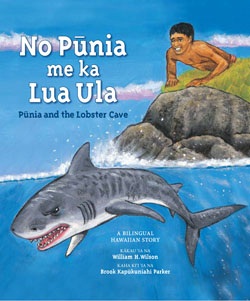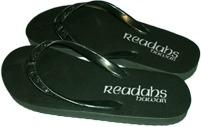Hey, did you know it’s Children’s Book Week? I feel like we say that a little too often, but it’s true. According to the Children’s Book Council, Children’s Book Week spans from May 2-8, 2011. So, if you haven’t read any books to your child yet this week (shame on you!), then now is a great time to go out and buy something new to celebrate this initiative! Oh, did I mention it’s also Children’s Day? Happy Keiki Day!

Misty recently reviewed I Choose You which is a great early chapter book from author Patricia Lei Murray. I’d like to continue with our keiki book reviews by taking a look at a 2011 Ka Palapala Poʻokela Award nominee in the Excellence in Children’s Literature category: No Pūnia me ka Lua Ula: Pūnia and the Lobster Cave by William H. Wilson, illustrated by Brook Kapūkuniahi Parker.
This bilingual Hawaiian book tells the story of a boy named Pūnia, whose father was killed by the shark aliʻi, Kaiʻaleʻale. Suddenly poor and eating only ʻuala (sweet potato) with his mother, Pūnia takes the initiative to go to his father’s lobster cave to get ula (lobster) to supplement their diet. Unfortunately, the lobster cave is guarded by Kaiʻaleʻale and his ten manō (shark) friends. Pūnia, however, outwits the manō and gets them to turn on themselves, killing each other one by one while Pūnia collects ula from the cave each time.
No Pūnia me ka Lua Ula is an illustrated re-telling of an old Hawaiian tale. For those of you familiar with the story, you will find that the book only covers Pūnia’s trickery of the sharks down to Kaiʻaleʻale, glossing over their final confrontation with the words, “But that is another story.” Do I smell a sequel? Aside from the truncation, the story is a rather straight-forward adaptation of the original tale, with a few added details to bring character and discussion to the story (which I’ll get to in my “Five Tips” paragraph).
As for the illustrations, I thought they were alright, nothing spectacular, though I do like the canvass-like texture of the art. I also enjoyed the way Parker distinguished the sharks from one another, although in a sense this made them a little too cute as I did feel some sympathy for them being killed off. I can imagine children possibly feeling the same way. There’s a fun page a few dead sharks in, where they summarize Pūnia’s pattern of trickery and count off the sharks being eliminated—the manō with the missing tooth, the one with the crooked back, the one missing a dorsal fin, the one with the blind eye, etc.—complete with a picture of them on the opposite page highlighting their unique features.
One of the things I really enjoy about keiki books from Kamehameha Publishing, are the “Five Tips for applying the lessons of this book” found at the very end. They provide questions and discussion points under five topics consistent throughout every book: ʻŌpio (children and youth), ʻOhana (extended family), Papa kula (classroom), Kaiaulu (community), and Lāhui (people, nation). It is here where the added details and issues I mentioned earlier are confronted. Some of the issues brought up include poverty, insufficient diet, helping others and natural resources. They even address the shark killing by saying that lying often causes somebody to become hurt or angry, then asking readers to discuss different ways of solving Pūnia’s dilemma without hurting anyone.
Overall, this is another fine addition to Kamehameha Publishing’s bilingual Hawaiian keiki books. It’s not one of the more standout inclusions to their library, but it provides a straightforward take, with good discussion points, for children to learn about one of Hawaiʻi’s classic tales of old.




